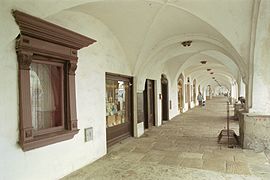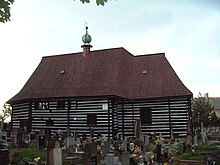Nové Město nad Metují
| Nové Město nad Metují | ||||
|---|---|---|---|---|
|
||||
| Basic data | ||||
| State : |
|
|||
| Region : | Královéhradecký kraj | |||
| District : | After that | |||
| Area : | 2312 ha | |||
| Geographic location : | 50 ° 21 ' N , 16 ° 9' E | |||
| Height: | 332 m nm | |||
| Residents : | 9,436 (Jan 1, 2019) | |||
| Postal code : | 549 01 | |||
| structure | ||||
| Status: | city | |||
| Districts: | 4th | |||
| administration | ||||
| Mayor : | Petr Hable (as of 2011) | |||
| Address: | náměstí Republiky 6 549 01 Nové Město nad Metují |
|||
| Municipality number: | 574279 | |||
| Website : | www.novemestonm.cz | |||
Nové Město nad Metují (German Neustadt an der Mettau ) is a town in Okres Náchod in the Czech Republic .
geography
Nové Město nad Metují is located in the foothills of the Eagle Mountains . The city is one of the most beautiful Renaissance cities in the Czech Republic and is a listed building. It lies on a rocky outcrop around which the Metuje (Eng. Mettau) flows on three sides .
Neighboring towns are Přibyslav and Náchod in the north, Nový Hrádek and Slavoňov in the east, Dobruška in the south, Černčice and Nahořany in the southwest, Doubravice (German: Daubrawitz) and Provodov-Šonov in the west and Václavice in the northwest. To the west are the local recreation area and the Rozkoš reservoir .
history
The place was founded in 1501 by Jan / Johann Černčický von Kácov , who owned the neighboring town of Krčín , as "Hradiště Nové Město nad Metují". In 1503 he gave him the rights and royal privileges of the town of Krčín, which sank into a village. He then had a rectangular market place and a fort built. The Church of the Holy Trinity was built on the south side of the market . The privileges - which included the right to market, the right to collect customs duties and the right to brew beer - resulted in rapid economic development. At that time 16 villages belonged to the Nové Město domain.
After the great city fire of 1526, the Lords of Pernstein acquired the city and dominion. They appointed Italian master builders and redesigned the market square with uniform facades, roof gables and arcades in the Renaissance style . The fort was also expanded and rebuilt. After the death of Johann von Pernstein , his heirs sold the property.
The next owners were the Lords of Stubenberg , who came from Styria and belonged to the Protestant line of this noble family. They had the fort rebuilt and expanded into a renaissance castle. Since Rudolf von Stubenberg was involved in the Bohemian class uprising , the city and rulership were confiscated by the emperor after the Battle of the White Mountains in 1620 .
City and rule then passed to Albrecht von Wallenstein , who sold the property to Maria Magdalena Trčka von Lobkowitz . She resided with her husband Jan Rudolf Trčka from Lípa on Opočno and in 1628 sold the town and the New Town to her son Adam Erdmann Trčka from Lípa . Since the Trčka von Leipa carried out a violent re-Catholicization on their property , there was an uprising of the peasant subjects in 1628.
After Adam Erdmann Trčka von Lípa, who was standing by Wallenstein's side, was murdered in Eger in 1634 , Emperor Ferdinand II, in his capacity as King of Bohemia, gave the town and rule of Neustadt to his Field Marshal Walter Leslie , who came from a Scottish noble family and participated in the plot against Wallenstein and whose followers were involved. From 1655 to 1661, Carlo Lurago had the palace rebuilt in the Baroque style. Walter's nephew Jacob von Leslie founded the monastery of the benevolent brothers with a hospital and the Church of the Birth of Mary.
After the Bohemian line of Leslies had expired in 1802, the town and rule were passed on to the von Dietrichstein family and, in 1858, to their more distant relatives ( from Liechtenstein , von Waldstein-Wartenberg, von Lamberg ), who did not reside in the city, which is good City and rule had a negative impact. The castle remained uninhabited or served other purposes and gradually fell into disrepair.
After the abolition of patrimonial Neustadt became an independent municipality in 1848, which from 1850 belonged to the Neustadt an der Mettau district .
In 1908 the textile industrialist Josef Bartoň bought the castle and the manor.
The city, which belonged to Czechoslovakia from 1918 , became part of the Protectorate of Bohemia and Moravia occupied by the German Reich in 1939 , with which it remained until the end of the war in 1945.
In 1948 the Bartoň-Dobenin family was expropriated without compensation by the communist Czechoslovak state. In 1992 the Nové Město Castle was restituted to the descendants of Josef Bartoň-Dobenin.
Tscherbeey manor
The Tscherbeey manor , located in the former county of Glatz , which also included the towns (Bad) Kudowa ( Chudoba ), Strausseney ( Stroužné ) and Jakubowitz ( Jakubovice ), also belonged to the new town from the 1590s until 1785 it was sold by Leslie's family to the Count Stillfried on Neurode . Since the end of the Second World War in 1945, the area has belonged to the Polish powiat Kłodzki .
Districts
The towns of Bradla ( Barren ), Krčín ( Rodwald ), Spy ( Spie ) and Vrchoviny ( Verkhovin ) belong to the town of Nové Město nad Metují .
Attractions
The historic city center was declared an urban monument reserve in 1970 .
- Nové Město nad Metují Castle
- The market square with Renaissance houses and arcades as well as the town hall
- The Church of the Holy Trinity in the south-east corner of the market square was built in 1519 and was given its current appearance in 1540. It houses old grave inscriptions , a baroque organ, an altar and frescoes.
- The plague column was erected in 1696.
- Statue of the Holy Trinity, erected in 1767 in gratitude for ending the Seven Years' War .
- Krčín, incorporated since 1949, is one of the oldest places in Eastern Bohemia. The Holy Spirit Church with the bell tower dates from the 13th century.
Sights in the area
- The wooden church of St. John the Baptist in Slavoňov was built in 1553 on the site of an older church and in 1705 it was decorated with wall paintings. Together with the bell tower and the cemetery, it forms a unique ensemble that has been included in the UNESCO list as a world heritage site.
- Peklo / Pekelské údoli (Devil's Valley): a destination in the romantic valley of the Mettau, with a former mill that was converted into an inn at the beginning of the 20th century according to plans by the architect Dušan Jurkovič .
- Výrov Castle, southeast of Nové Město
economy
Nové Město nad Metují is the hometown of the former Czech construction machinery manufacturer Stavostroj , which was taken over by the Swiss Ammann Group in 2005 .
sons and daughters of the town
- Johann Wilhelm von Stubenberg (1619–1663), baroque poet and translator
- Philipp Josef Pick (1834–1910), dermatologist
- Jan Milič Lochman (1922–2004), pastor of the Evangelical Church of the Bohemian Brethren and professor of systematic theology at the University of Basel
- Pavel Brendl (* 1981), ice hockey player
Twin cities
Nové Město nad Metují is a member of the Neustadt in Europa working group , in which 37 towns and municipalities with the place name Neustadt from Germany, Austria, Hungary, the Czech Republic, Poland, Slovakia and the Netherlands have come together. In 2001 Nové Město nad Metují hosted the annual New Town meeting.
Sister cities are:
- Duszniki-Zdrój , Poland
- Hilden , Germany
- Warrington , England
literature
- Joachim Bahlcke , Winfried Eberhard, Miloslav Polívka (eds.): Handbook of historical places . Volume: Bohemia and Moravia (= Kröner's pocket edition . Volume 329). Kröner, Stuttgart 1998, ISBN 3-520-32901-8 , pp. 405-406.
- Erhard Gorys : DuMont art travel guide Czech Republic. Culture, landscape and history in Bohemia and Moravia. DuMont, Cologne 1994, ISBN 3-7701-2844-3 , pp. 324-325.
- Anne Kotzan: Knaur's cultural guide in color Czech Republic, Slovak Republic , Droemer Knaur, Munich 1993, ISBN 3-426-26609-1 , pp. 162–163
- Johann Gottfried Sommer : The Kingdom of Bohemia Vol. 4: Königgrätzer Kreis , Prague 1836, pp. 196–211 digitized
Web links
Individual evidence
- ↑ Český statistický úřad - The population of the Czech municipalities as of January 1, 2019 (PDF; 7.4 MiB)
- ↑ Jaroslav Šůla: Dva kšafty Jana Rudolfa Trčky z Lípy. In: Stopami Dějin Náchodska, 5/1999, ISBN 80-902158-5-8 , p. 165
- ↑ Frantisek Musil: K počátkům Českého koutku v Kladsku . In: Kladský sborník , Supplementum, Hradec Králove 2008, p. 21f.
- ↑ Ondřej Felcman: Český koutek v Kladském Hrabství - jeho české kořeny a následné vztahy k českémi sousedství . In: Kladský sborník, Supplementum, Hradec Králove 2008, p. 28.
- ↑ Hrad Výrov on the official websites of Nové Město nad Metují [21. 9. 2019]








